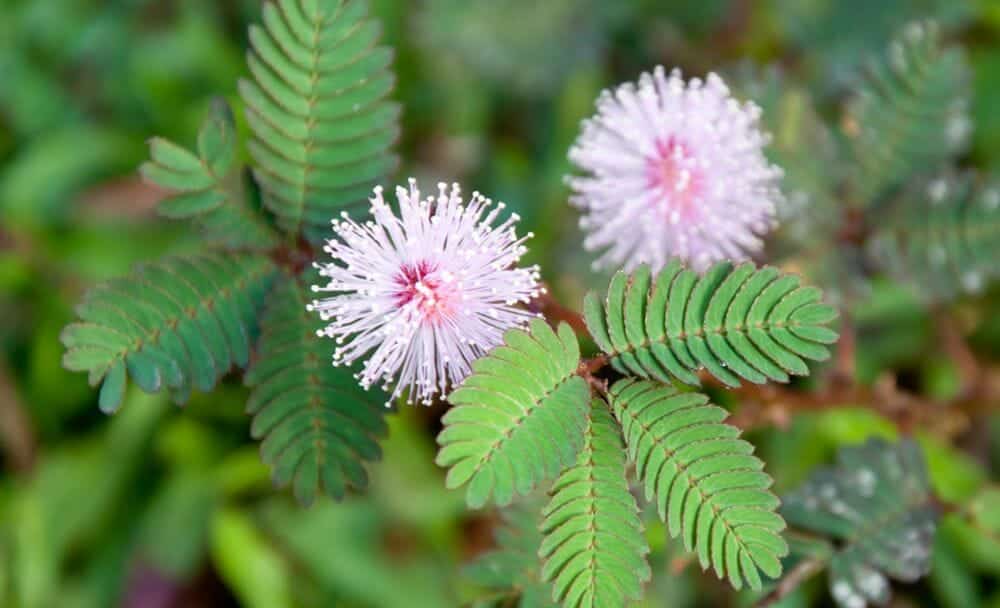
Mimosa Pudica, commonly known as Lajwanti or Touch-Me-Not, is a fascinating plant with a rich history of traditional use in various cultures. Renowned for its unique ability to respond to touch by rapidly closing its leaves, the Mimosa Pudica plant has captured the attention of researchers and herbalists who have put forward several theories regarding this phenomenon, such as the migration of potassium from the motor cell to intercellular spaces when Mimosa is stimulated. [1] Beyond its intriguing behavior, this plant offers a range of potential benefits and uses.
Its remarkable pharmacological attributes include its potential as an anti-diabetic, antitoxin, antihepatotoxin, antioxidant, and wound-healing agent. The plant contains alkaloids, glycosides, flavonoids, and tannins. Its versatile applications encompass the suppression of kapha and pitta, wound healing, blood coagulation, and addressing sexual weakness. Every part of lajwanti, which is the mimosa pudica common name, is recognized for its medicinal potential and is employed in treating a spectrum of conditions, ranging from biliousness, leprosy, dysentery, vaginal and uterine complaints, inflammations, burning sensations, fatigue, asthma, to even leucoderma and blood disorders. [2]
In this article, we will focus on its several uses, benefits, dosage, and precautions that must be considered.
Uses of Mimosa Pudica

According to the traditional healthcare system, all five plant components namely leaves, flowers, stems, roots, and fruits (panchang), are known for their immense mimosa pudica medicinal uses. [4]
- Parts of the plant can treat health issues like leprosy, dysentery, vaginal and uterine complaints, inflammations, burning sensation, asthma, leucoderma, fatigue, and blood diseases. If you experience Agnimandya (low digestive fire) due to poor eating habits, it may lead to the imbalance of Kapha dosha resulting in the accumulation of Ama which gets mixed with the stool and causes flatulence sometimes. Lajvanti helps digest Ama and reduces the symptoms of Dysentery due to its Kapha balancing property.
- The root is considered useful for diseases arising from blood impurities and bile, including bilious fevers, piles, jaundice, and leprosy.
- A decoction is used for balancing Kapha, helping with toothache, diarrhea or atisar, amoebic dysentery, bleeding piles, and urinary infections.
- It accelerates wound healing and is utilized in herbal preparations for gynecological disorders.
- It is known for its potential to treat skin diseases, bronchitis, general weakness, impotence, and neurological problems.
- Research indicates the extract’s potential use in managing childbirth and as a contraceptive alternative.
- Mimosa bark relaxes the mind and relieves stress, depression, mental distress, irritability, palpitations, and amnesia. It improves mood and blood circulation and helps prevent baldness.
- This plant promotes healthy cell growth and is included in shampoos, creams, capsules, and soaps.
- Mimosa root finds application in treating insomnia, premenstrual syndrome (PMS), hemorrhoids, menorrhagia, skin wounds, and diarrhea. It is also used for whooping cough and fevers in children and might alleviate rheumatoid arthritis symptoms. [2]
Benefits of Mimosa Pudica
Antidepressant action:
One of the primary mimosa pudica benefits includes its ability to alleviate depression. [5]
Parasite Cleanse:
One of the most popular uses of Mimosa Pudica is for potential parasite cleansing. Some herbalists and natural health enthusiasts believe that the plant’s seeds may help eliminate parasites from the digestive tract due to their purported anthelmintic properties. [2]
Aphrodisiac property:
Mimosa Pudica has been associated with aphrodisiac properties with the potential to enhance sexual desire and performance. [5]
Wound Healing:
In some traditional systems of medicine, extracts from Mimosa Pudica have been applied topically to wounds for their potential wound-healing properties. [3] Lajvanti helps in wound healing due to its Sita (cool) and Ropan (healing) properties. These aid in reducing the pain and inflammation alongside promoting the healing of the wounds.
Urinary Tract Health:
It is believed that Mimosa Pudica may help support urinary tract health due to its potential diuretic properties, aiding in promoting urine flow. [3]
Antioxidant Effects:
The plant contains antioxidants that can help neutralize the cell-damaging free radicals in the body, potentially contributing to overall health and well-being. [2]
Managing Diabetes:

Diabetes, referred to as Madhumeha in Ayurveda, emerges from the exacerbation of Vata-Kapha dosha along with compromised digestion. This compromised digestion results in the accumulation of Ama (toxic residues resulting from incomplete digestion) within pancreatic cells, subsequently hindering insulin function. Lajvanti contributes to upholding the regular performance of insulin and supporting diabetes management, attributable to its property of balancing Kapha dosha. [6]
Dosage for Mimosa Pudica
Dosage recommendations for Mimosa Pudica can vary depending on the form of the supplement (capsules, powder, tincture) and the specific purpose for which it is being used. Dosages generally range from 200 and 500 mg to 2 grams per day, but this can differ based on factors such as individual tolerance and health status. [5]
FAQs
1. What are some safety considerations and precautions that must be kept in mind while using the Mimosa plant?
1. Toxicity: All parts of the Mimosa plant are reportedly toxic if ingested directly and thus must be consulted by a physician first.
2. Allergies: Individuals with a history of allergies, especially to plants in the Fabaceae family, should exercise caution when using Mimosa Pudica supplements.
3. Pregnancy and Breastfeeding: Pregnant & breastfeeding women should avoid using Mimosa Pudica supplements due to a lack of sufficient safety data.
4. Medication Interactions: There is limited research on the interactions of Mimosa Pudica with medications. If you are on medication, consult a healthcare provider before using this herb to prevent any potential interactions.
5. Dosage and Duration: As with any supplement, it is important to adhere to recommended dosages and not exceed them. Prolonged use of high doses may lead to adverse effects.
6. Digestive Discomfort: Some individuals may experience gastrointestinal discomfort, including bloating and gas, when using Mimosa Pudica supplements. If these symptoms arise, discontinue use and consult a healthcare professional.
2. Is Mimosa Pudica Beneficial for Gastric Ulcers?
From an Ayurvedic perspective, gastric or stomach ulcers stem from indigestion and an imbalance in the Pitta dosha. This condition leads to symptoms such as a burning sensation. Mimosa Pudica, or Lajvanti, is beneficial in managing gastric ulcers due to its ability to balance the Pitta dosha and its Sita (cold) properties. By addressing these imbalances, it aids in reducing the burning sensation and providing relief from gastric ulcer symptoms. [6]
3. How to Use Mimosa Pudica (Lajvanti) Plant for Piles?
From an Ayurvedic viewpoint, Lajvanti, or mimosa pudica in Hindi, is an effective remedy for managing piles, particularly symptoms like bleeding. This is attributed to its Kashaya (astringent) property, which assists in arresting bleeding and facilitating swift healing. [6]
Conclusion
Mimosa Pudica, with its captivating leaf-closing response and potential health benefits, continues to capture the attention of those interested in traditional and natural remedies. While its uses for digestive health, potential parasite cleansing, anti-inflammatory effects, and more are intriguing, it is essential to approach its consumption with caution.
Disclaimer:
This article is written from a health and wellness perspective and is not medical advice. Kindly seek the help of a certified medical practitioner before initiating any treatment.
References:
- Mimosa pudica L. a sensitive plant
- Pharmacology and Traditional Uses of Mimosa pudica
- Mimosa pudica L. (Laajvanti): An overview
- A review on ethnomedical and traditional uses of Mimosa pudica
- Mimosa pudica L. (Laajvanti): An overview
- Antidiabetic Efficacy of Mimosa pudica (Lajwanti) Root in Albino Rabbits












